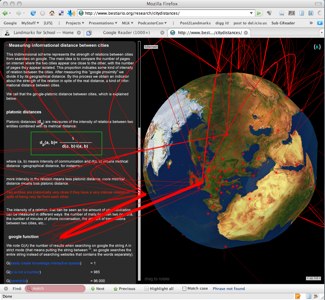 I’m not sure what value it would be to your daily classroom or school management task. The term, Google Platonic Distance, is an invention of a Barcelona group called bestiario. They use a combination of art, design, and scientific computation to generate useful visualizations of vast information sets and complex systems.
I’m not sure what value it would be to your daily classroom or school management task. The term, Google Platonic Distance, is an invention of a Barcelona group called bestiario. They use a combination of art, design, and scientific computation to generate useful visualizations of vast information sets and complex systems.
I learned about this example of their work from a Smart Mobs article ((Breck, Judy. “Smart Mobs Measure Informational Distance.” [Weblog SmartMobs] 29 Apr 2008. 1 May 2008 http://www.smartmobs.com/2008/04/29/smart-mobs-measure-informational-distance/.)) by Judy Breck. The site measures and illustrates the information distance between cities, the apparent degree to which major cities are linked through the World Wide Web. They calculate the informational distance by comparing the number of web pages that include the names of two cities close to each other, to the number of pages that include only one of the city names (gracias a Google). The result is called the “Google Proximity,” and this number is divided by the geographic distance between the cities. There is a much more detailed explanation on the web page.
Again, I’m not sure of the practical applications of this kind of visualization, except that it is another, among many examples of how today’s globally networked and digital information landscape can be “worked.” This particular visualization strikes in my brain a sense that the world is not so much becoming smaller as it is becoming twisted and puckered, like a potato that’s gone bad. Parts of the planet have come closer together informationally and culturally (Europe, North America, Southern Asia, and an incredibly conversational Australia), while informational distances in other parts of the inhabited world remain vast (South America and Africa).
Instructionally, I believe that it is important to show students this sort of thing — and often. It can give them a sense that the networked, digital, and overwhelming content around us is workable in ways that produces value. It is literacy (skills involved in using information to accomplish goals) as well. The visualization of global connections is one more illustration of how arithmetic is no longer simply the ability to process numbers on a piece of paper — that it is a range of skills involved in employing information — working the binary numbers that define nearly all content today — to answer questions, solve problems, and accomplish goals.
Now this does not mean that every student (or teacher) should know how to produce this type of visualization. But I think that a literate person today should be confident that if he or she need to be able to produce this kind of visualization, then we could use our learning-literacy skills to teach ourselves how to do it.
2¢ Worth

David,
I think this will be a great visual to use when teaching the concept of “transactional distance” (http://www.aged.tamu.edu/research/readings/Distance/1997MooreTransDistance.pdf) to teachers who attend our workshops on Effective Online Instruction and Effective Videoconference Instruction at Region 16 ESC. Although not quite the same, it may be just the visual needed to help with the grasp of that somewhat difficult concept.
Thanks for the great resource!